 W
WThe American Revolutionary War saw a series battles involving naval forces of the British Royal Navy and the Continental Navy from 1775, and of the French Navy from 1778 onwards. Although the British enjoyed more numerical victories, these battles culminated in the surrender of the British Army force of Lieutenant-General Earl Charles Cornwallis, an event that led directly to the beginning of serious peace negotiations and the eventual end of the war. From the start of the hostilities, the British North American station under Vice-Admiral Samuel Graves blockaded the major colonial ports and carried raids against patriot communities. Colonial forces could do little to stop these developments due to British naval supremacy. In 1777, colonial privateers made raids into British waters capturing merchant ships, which they took into French and Spanish ports, although both were officially neutral. Seeking to challenge Britain, France signed two treaties with America in February 1778, but stopped short of declaring war on Britain. The risk of a French invasion forced the British to concentrate its forces in the English Channel, leaving its forces in North America vulnerable to attacks.
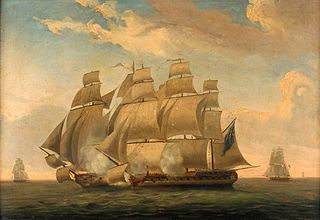 W
WThe action of 2 January 1783 was a minor naval battle that took place in the Caribbean Sea during the last stages of the American War of Independence. Severe fighting between a Royal Navy frigate HMS Magicienne and a French frigate Sibylle went on for nearly two hours, but in that time both frigates were reduced to wrecks.
 W
WThe action of 6 October 1779 was a minor but famous and furious naval engagement that took part in the early stages of the war between Britain and France in the American Revolutionary War between the British Royal Navy frigate HMS Quebec and the frigate Surveillante of the French Navy. The battle ended in a French victory when Quebec was destroyed by an explosion.
 W
WThe action of 9 August 1780 was a naval engagement of the American Revolutionary War, in which a Spanish fleet, led by Admiral Luis de Córdova y Córdova, along with a squadron of French ships, encountered a large British convoy. The Spanish and French force captured almost all the merchant vessels in the convoy, which dealt a severe blow to the commerce of Great Britain.
 W
WThe action of 12 December 1782 was a naval engagement fought off the coast of Spain near Ferrol, in which the British 40-gun fifth rate HMS Mediator successfully attacked a convoy of five armed ships. Mediator succeeded in capturing one American privateer, the Alexander, and then captured the French ex-ship of the line La Ménagère. The convoy was part of Pierre Beaumarchais's supply chain to the American colonists.
 W
WThe action of 16 March 1782 was a naval engagement between a British Royal Naval frigate HMS Success and a Spanish frigate Santa Catalina in the Strait of Gibraltar during the American War of Independence.
 W
WThe action of 17 June 1778 also known as the Fight of Belle Poule and Arethusa was a minor naval action that took place off the coast of France between British and French frigates. The action was widely celebrated by both France and Great Britain and was the first between the two naval forces during the American Revolutionary War before a formal declaration of war was even announced.
 W
WThe action of 21 July 1781 was a naval skirmish off the harbour of Spanish River, Cape Breton, Nova Scotia, during the War of American Independence. Two light frigates of the French Navy, captained by La Pérouse and Latouche Tréville, engaged a convoy of 18 British ships and their Royal Navy escorts. The French captured two of the British escorts while the remainder of the British convoy escaped.
 W
WThe action of 25 February 1781 was a naval engagement fought off Cape Finisterre between the Spanish naval frigate sixth rate Graña of 30 guns and the Royal Navy fifth-rate frigate HMS Cerberus of 32 guns. Graña surrendered after a hard fight.
 W
WThe action of 29 July 1782 was a minor naval engagement that took place towards the end of the American War of Independence. The British Royal Navy frigate HMS Santa Margarita captured the 36-gun French frigate Amazone off Cape Henry, but the next day the squadron under Louis-Philippe de Vaudreuil intervened and recaptured the frigate.
 W
WThe action of 30 September 1780 was a minor naval engagement off the Bermudas, where HMS Pearl captured Espérance, a French frigate of 32 guns launched in 1779.
 W
WThe Battle off Barbados was fought in March 1778 during the American Revolutionary War. While escorting a fleet of American ships in the West Indies, the frigate USS Randolph was attacked by the British ship-of-the-line HMS Yarmouth. The following action resulted in America's most costly naval defeat, in terms of human lives, until the sinking of USS Arizona in 1941.
 W
WThe Battle of Kedges Strait took place on November 30, 1782 near Tangier Sound in Chesapeake Bay near the town of Onancock, Virginia, between naval militia forces of the rebellious British colony of Maryland and the Royal Navy of Great Britain.
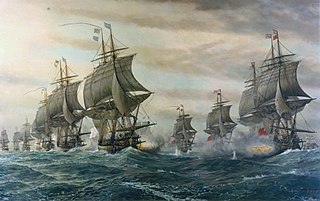 W
WThe Battle of the Chesapeake, also known as the Battle of the Virginia Capes or simply the Battle of the Capes, was a crucial naval battle in the American Revolutionary War that took place near the mouth of the Chesapeake Bay on 5 September 1781. The combatants were a British fleet led by Rear Admiral Sir Thomas Graves and a French fleet led by Rear Admiral Francois Joseph Paul, the Comte de Grasse. The battle was strategically decisive, in that it prevented the Royal Navy from reinforcing or evacuating the besieged forces of Lieutenant General Lord Cornwallis at Yorktown, Virginia. The French were able to achieve control of the sea lanes against the British and provided the Franco-American army with siege artillery and French reinforcements. These proved decisive in the Siege of Yorktown, effectively securing independence for the Thirteen Colonies.
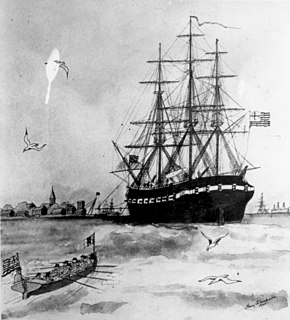 W
WThe Battle of Block Island was a naval skirmish which took place in the waters off Rhode Island during the American Revolutionary War. The Continental Navy under the command of Commodore Esek Hopkins was returning from a successful raid on Nassau when it encountered HMS Glasgow, a Royal Navy dispatch boat.
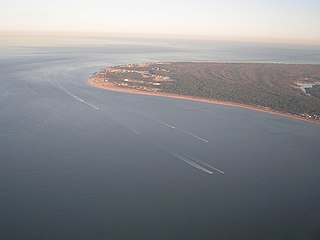 W
WThe Battle of Cape Henry was a naval battle in the American War of Independence which took place near the mouth of Chesapeake Bay on 16 March 1781 between a British squadron led by Vice Admiral Mariot Arbuthnot and a French fleet under Admiral Charles René Dominique Sochet, Chevalier Destouches. Destouches, based in Newport, Rhode Island, had sailed for the Chesapeake as part of a joint operation with the Continental Army to oppose the British army of Brigadier General Benedict Arnold that was active in Virginia.
 W
WThe Battle of Cape Spartel was an indecisive naval battle between a Franco-Spanish fleet under Admiral Luis de Córdova y Córdova and a British fleet under Admiral Richard Howe. These forces met on 20 October 1782 after Howe successfully resupplied Gibraltar, then under siege by Bourbon forces during the American Revolutionary War.
 W
WThe Battle of Blomindon took place on 21 May 1781 during the American Revolutionary War. The naval battle involved three armed U.S. privateer vessels against three Nova Scotian vessels off Cape Split, Nova Scotia. American Privateers caught two Nova Scotia Vessels. The first Nova Scotia vessel was re-captured by Lieut Benjamin Belcher. The second Nova Scotia vessel was overtaken by the captured crew under the command of Captain Bishop. The privateers were taken to Cornwallis and put on trial.
 W
WThe American frigate USS Hancock was captured by the British Royal Navy in a 1777 naval battle during the American Revolutionary War. The two highest ranking naval officers of the war battled each other off the coast of Nova Scotia. HMS Rainbow, under the command of British Admiral George Collier, captured USS Hancock, under the command of Captain John Manley.
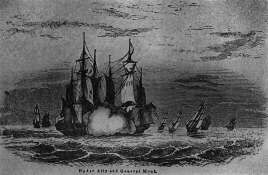 W
WThe Battle of Delaware Bay, or the Battle of Cape May, was a naval engagement fought between the Kingdom of Great Britain and the United States during the American Revolutionary War. A British squadron of three vessels attacked three American privateers that were escorting a fleet of merchantmen. The ensuing combat in Delaware Bay near Cape May ended with an American victory over a superior British force.
 W
WThe Battle of the Delaware Capes or the 3rd Battle of Delaware Bay was a naval engagement that was fought off the Delaware River towards the end of the American Revolutionary War. The battle took place on 20 and 21 December 1782, some three weeks after the signing of the preliminary articles of peace between Great Britain and the former American colonies. It was an engagement between three British Royal Navy frigates HMS Diomede, Quebec and Astraea on the one side, and the South Carolina Navy's 40-gun frigate South Carolina, the brigs Hope and Constance, and the schooner Seagrove on the other. The British were victorious, with only Seagrove escaping capture.
 W
WThe capture of Demerara and Essequibo was a French military expedition carried out in January 1782 as part of the American Revolutionary War. In 1781 Admiral Lord Rodney sent two sloops from his fleet at Sint Eustatius to take possession of the Dutch colonies of Essequibo and Demerara. In 1782 the French successfully took possession of these settlements, compelling British Governor Robert Kingston to surrender. The Treaty of Paris in 1783 restored these territories to the Dutch.
 W
WThe Invasion of Dominica was a successful French invasion of the island of Dominica in the British West Indies, during the American Revolutionary War. The action took place before British authorities in the Caribbean were aware that France had entered the war as an ally of the United States of America. The French governor in the West Indies, François Claude Amour, marquis de Bouillé, was notified on 17 August that France was at war, and organized the invasion, infiltrating spies to rally sympathetic French-speaking Dominican support.
 W
WThe Battle off Fairhaven was the first naval engagement of the American Revolutionary War. It took place on May 14, 1775, in Buzzards Bay off Fairhaven, Massachusetts and resulted in Patriot militia retrieving two vessels that had been captured by HMS Falcon. The patriots also captured the 13 man crew of the Royal Navy, the first naval prisoners of the war.
 W
WThe Battle of Flamborough Head was a naval battle that took place on 23 September 1779 in the North Sea off the coast of Yorkshire between a combined Franco-American squadron, led by Continental Navy officer John Paul Jones, and two British escort vessels protecting a large merchant convoy. It became one of the most celebrated naval actions of the war in America, despite its relatively small size and a considerable dispute over what had actually occurred.
 W
WThe Frederica naval action was a naval battle during the American Revolutionary War in which three galleys of the Georgia State Navy defeated a British raiding party off the coast of Georgia. The action occurred on April 19, 1778.
 W
WThe Battle of Gloucester was a skirmish fought early in the American Revolutionary War at Gloucester, Massachusetts on August 8 or 9, 1775. Royal Navy Captain John Linzee, commanding the sloop-of-war HMS Falcon, spotted two schooners that were returning from the West Indies. After capturing one schooner, Linzee chased the second one into Gloucester Harbor, where it was grounded. The townspeople called out their militia, captured British seamen sent to seize the grounded schooner, and recovered the captured ship as well.
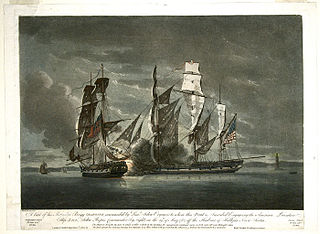 W
WThe Battle off Halifax took place on 28 May 1782 during the American Revolutionary War. It involved the American privateer Jack and the 14-gun Royal Naval brig HMS Observer off Halifax, Nova Scotia. Captain David Ropes commanded Jack, and Lieutenant John Crymes commanded Observer. The battle was "a long and severe engagement" in which Captain David Ropes was killed.
 W
WThe Capture of HMS Savage was a naval battle of the Revolutionary War involving the American privateer Congress and the British sloop-of-war HMS Savage. It occurred in September 1781 off South Carolina and is considered one of the hardest-fought single ship actions of the war.
 W
WThe Battle off Liverpool took place on 24 April 1778 during the American Revolutionary War. The raid involved the British vessel HMS Blonde and the French 24-gun frigate Duc de Choiseul.
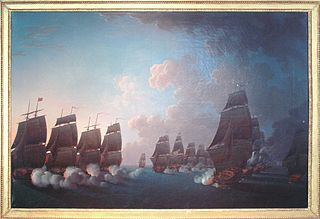 W
WThe Battle of Martinique, also known as the Combat de la Dominique, took place on 17 April 1780 during the American Revolutionary War in the West Indies between the British Royal Navy and the French Navy.
 W
WThe Battle of the Mona Passage was a naval engagement on 19 April 1782 taking place in the aftermath of the Battle of the Saintes between Britain and France during the American Revolutionary War. A British fleet under Rear-Admiral Sir Samuel Hood, pursued a small French fleet under Georges-François de Framond which had managed to escape the victorious British fleet a week earlier. The two fleets met and engaged at the Mona Passage where the British overtook and captured four French ships, two of which were 64-gun ships of the line.
 W
WThe Raid on Annapolis Royal took place on 29 August 1781 during the American Revolutionary War. The raid involved two American privateers - the Resolution and the Reprisal - attacking and pillaging Annapolis Royal, Nova Scotia in revenge of the defeat of the Penobscot Expedition. The privateers took captive the commander of the militia John Ritchie, described as the "Governor of Annapolis." One historian described it as "one of the most daring and dramatic raids upon Nova Scotia."
 W
WThe Raid on Canso took place on 22 September – November 22, 1776 during the American Revolutionary War. The raid involved American Continental Navy captain John Paul Jones attacking Canso, Nova Scotia and the surrounding fishing villages.
 W
WThe Raid on Charlottetown took place on 17-18 November 1775 as part of the Washington's first naval expedition during the American Revolutionary War. The raid involved two American privateers of the Marblehead Regiment attacking and pillaging Charlottetown. As a result of the expedition, the Governor of Nova Scotia Francis Legge declared martial law throughout the colony. The raid resulted in a diplomatic crisis for George Washington when the privateers overstepped their orders and took prisoner the Acting Governor, the Naval Commander and the Surveyor General of the colony.
 W
WThe Raid on St. John took place on 27 August 1775 during the American Revolutionary War. The raid involved American privateers from Machias, Maine attacking St. John, Nova Scotia. The privateers intended to stop the export of supplies being sent to the loyalists in Boston. This raid was the first hostile act committed against Nova Scotia and it resulted in raising the militia across the colony.
 W
WFrancis Reynolds-Moreton, 3rd Baron Ducie was a British naval officer who commanded a number of ships before, during and after the American Revolutionary War. He is largely noted for his role as a naval officer during the Revolutionary War at the Battle of Red Bank in 1777 during the Philadelphia campaign on the Delaware River, involving the dual siege of Fort Mifflin and Fort Mercer. During this operation he was commander of the advance fleet on board HMS Augusta in an attempt to clear the way along the Delaware to Philadelphia. His ship ran aground while being pursued by Commodore Hazelwood's fleet when the vessel mysteriously caught fire shortly thereafter and exploded before all of the crew could abandon ship. Reynolds also commanded HMS Jupiter and HMS Monarch in several operations and saw service against the French in the North Sea, European Atlantic coast and the Caribbean theaters.
 W
WThe Battle of Sadras was the first of five largely indecisive naval battles fought between a British fleet and a French fleet off the east coast of India during the Anglo-French War. Fought on 17 February 1782 near present-day Kalpakkam, the battle was tactically indecisive, but the British fleet suffered the most damage. Under Suffren's protection, French troop transports were able to land at Porto Novo, present-day Parangipettai.
 W
WThe Battle of Saint Kitts, also known as the Battle of Frigate Bay, was a naval battle fought on 25 and 26 January 1782 during the American Revolutionary War between a British fleet under Rear Admiral Sir Samuel Hood and a larger French fleet under the Comte de Grasse.
 W
WThe Battle of St. Lucia or the Battle of the Cul de Sac was a naval battle fought off the island of St. Lucia in the West Indies during the American Revolutionary War on 15 December 1778, between the British Royal Navy and the French Navy.
 W
WThe Capture of HMS St Fermin was a naval engagement that took place off Málaga on 4 April 1781, during the American Revolutionary War. Spanish xebecs San Antonio and San Luis captured the sloop-of-war HMS St Fermin.
 W
WThe Battle of Turtle Gut Inlet was an important, early naval victory for the Continental Navy and the future "Father of the American Navy", Captain John Barry. It was the first privateer battle of the American Revolutionary War. The battle resulted in the first American casualty of the war in New Jersey, Lieutenant Richard Wickes, brother of Captain Lambert Wickes. It was the only Revolutionary War battle fought in Cape May County.
 W
WThe Battle of Ushant took place on 27 July 1778, and was fought during the American Revolutionary War between French and British fleets 100 miles (160 km) west of Ushant, an island at the mouth of the English Channel off the north-westernmost point of France. "Ushant" is the Anglicised pronunciation of "Ouessant".
 W
WThe Battle of Valcour Island, also known as the Battle of Valcour Bay, was a naval engagement that took place on October 11, 1776, on Lake Champlain. The main action took place in Valcour Bay, a narrow strait between the New York mainland and Valcour Island. The battle is generally regarded as one of the first naval battles of the American Revolutionary War, and one of the first fought by the United States Navy. Most of the ships in the American fleet under the command of Benedict Arnold were captured or destroyed by a British force under the overall direction of General Guy Carleton. However, the American defense of Lake Champlain stalled British plans to reach the upper Hudson River valley.
 W
WThe Battle off Yarmouth took place on 28 March 1777 during the American Revolutionary War off the coast of Yarmouth, Nova Scotia. The battle is the first American armed vessel to engage the British Navy. The British vessel HMS Milford forced the American USS Cabot aground and the American crew escaped among the inhabitants of Yarmouth.